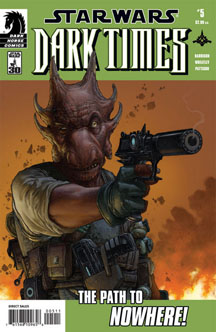Because Obi-Wan equates the “dark times” with the Empire (“That was before the dark times, before the Empire”), one would assume the “Dark Times” comic book series explores people living under the oppression of the New Order. But interestingly, this series – which takes place immediately in the wake of Order 66 and Palpatine’s declaration of the Galactic Empire – tells of people living in anarchic chaos rather than stifling order.
This is a savvy move by writer Randy Stradley (writing under the pen names Welles Hartley and Mick Harrison), because transitions of government throughout Earth history are often messy affairs that don’t happen overnight, regardless of official proclamations. By the time of the “Rebels” TV series 15 years later, we will indeed see the Empire’s terrifying order. But it takes time to establish it. As such, “Dark Times” is more about living without the Republic and the Jedi than it is about living under the Empire.
Somewhat surprisingly, Emperor Palpatine – a master manipulator as he rose to power — is now quite blunt as he goes about consolidating his power in “Dark Times” Issues 1-10 (2006-08). Even Darth Vader is exasperated by Palpatine’s approach, particularly when it comes to the Empire rounding up and selling Nosaurians (whose government had sided with the Separatists) on the slave market. Historically, a new imperial government will want to secure its power by going after a naïve citizenry’s good graces. In order to get people to gladly pay taxes, and to get enough of them to join the military, an empire would presumably want to shut down the slave trade, or at least make it appear it is doing so.
However, Palpatine is already arrogantly governing by dictate, and he orders the slaves to be sold on the open market, with the Empire pocketing the profits. The Emperor bends the truth when explaining the situation to Vader, claiming the slaves are working for the Empire (and one can only assume Palpatine is telling even more brazen lies to the citizenry).
Some of Vader’s scenes in the opening arc, “The Path to Nowhere” (Issues 1-5), come from James Luceno’s novel “Dark Lord: The Rise of Darth Vader” (2005), which you’ll want to read for a more Vader-centered story. Vader will no doubt factor more into “Dark Times” as it goes forward, but “Path to Nowhere” is primarily the story of Nosaurian Bomo Greenbark and his Jedi ally Dass Jennir, who met in “Republic” Issues 79-80. They join a crew of smugglers on the Uhumele, which is this series’ answer to “Knights of the Old Republic’s” Last Resort and “Firefly’s” Serenity.
Stradley delivers an incredibly dark storyline for Bomo, who learns his daughter was sold at the slave market and his wife was killed trying to stop the sale. Then it turns out that the guy who purchased Bomo’s daughter killed and ate her. As such, it’s refreshing to find that the Uhumele is genuinely welcoming to the distraught Bomo. The bonding of the makeshift family is shown subtly by artist Douglas Wheatley, a master at telling a story through visuals: For example, some panels show the diminutive Ratty cautiously placing a hand on Bomo’s arm to try to comfort him.

“Dark Times” is a lot of fun for fans of “Star Wars” fauna, as the Uhumele’s Captain Heren is a Yarkora (think Yak Face, he of the famously rare Original 93 action figure), engineer Ratty is a Tintinna (introduced in the “Holiday Special”) and navigator Sniffles is an Elomin (introduced in “Heir to the Empire”).
Countless stories have chronicled Jedi dealing with the dark side, but “Dark Times” might be the meatiest. At the end of “Path to Nowhere,” Jennir kills Dezono Qua, the “man of means” who murdered and ate Bomo’s daughter. Jennir says he killed Qua to spare Bomo from having to do it (“Killing him would have taken something from your soul”). Then Jennir goes off to deal with what he has done.
K’Kruhk, a Whiphid Jedi Master who appeared in numerous “Republic” comics, finds himself in a similar situation by the end of “Parallels” (Issues 6-10), which is inferior to “Path to Nowhere” only because isn’t drawn by Wheatley. The art by Dave Ross and Lui Antonio isn’t bad, and it’s neat to return to the swamp planet Mimban (from “Splinter of the Mind’s Eye”), but they commit the crime of not being Wheatley.
K’Kruhk kills a bunch of kidnappers looking to ransom the Jedi children under his protection. Like Jennir, K’Kruhk thinks he has done something wrong: “They didn’t deserve to die that way. It was wrong. I was wrong.”
My initial reactions to Jennir’s and K’Kruhk’s self-flagellation is that it’s nonsense. Those bad guys had it coming (indeed, Stradley makes them unambiguously bad: kidnappers and kid-eaters, for god’s sake), and if Jedi are the guardians of peace AND justice, well, justice often consists of good people using violence to stop bad people from using violence against innocents. It’s unlikely K’Kruhk could have merely subdued all the kidnappers. In Jennir’s case, while he could have arrested Dezono Qua, to what authority would he hand the suspect over? Not the Empire, as it is hunting Jedi, and probably not the planetary government, which is probably controlled by the Empire to some degree.
Granted, K’Kruhk does find a nice empty world where “game and fruit are plentiful,” and he sets up a sort of mini-Jedi Academy. That’s part of the hook of “Dark Times” and many other dark “Star Wars” stories: The idea that there is a little slice of freedom to be found somewhere among the stars. But, of course, the Empire always finds you eventually, especially if you have a target on your back, as all Jedi do.
As “Dark Times” goes forward, Jennir and K’Kruhk will fight their inner demons. As a reader, I’m thinking “As long as you remain on the side of good, go ahead and use the dark side.” It’s easy for me to say, as only people who have taken a life (even if in self-defense of others) can truly say what it does to one’s soul. But it feels right to kill scum like Dezono Qua. And that’s why “Dark Times” is off to such a good start.

